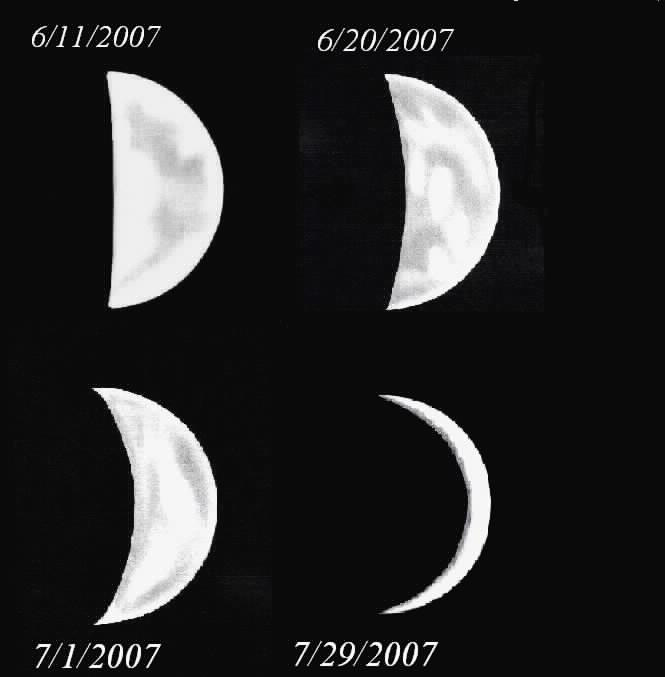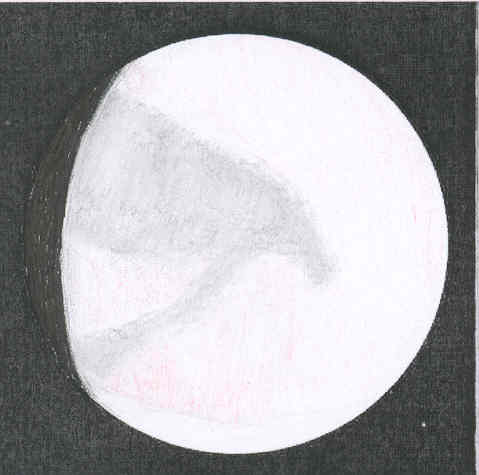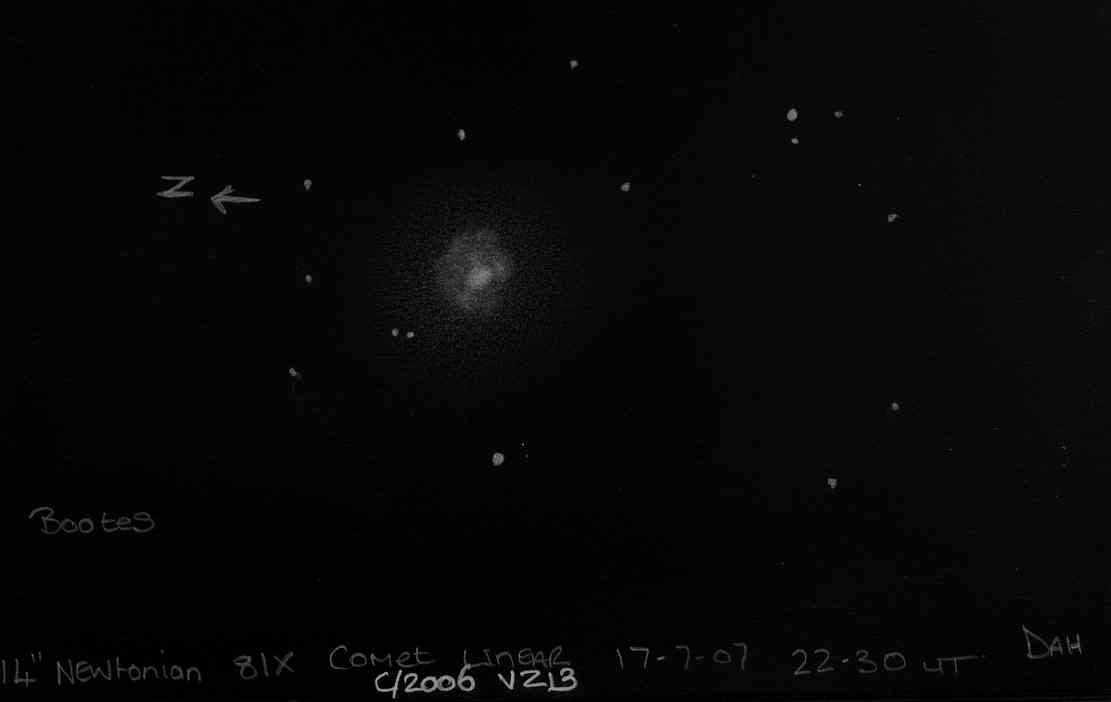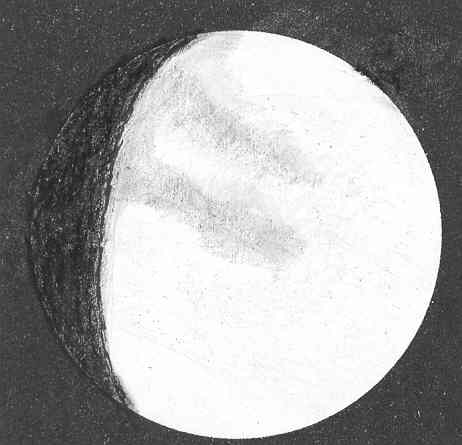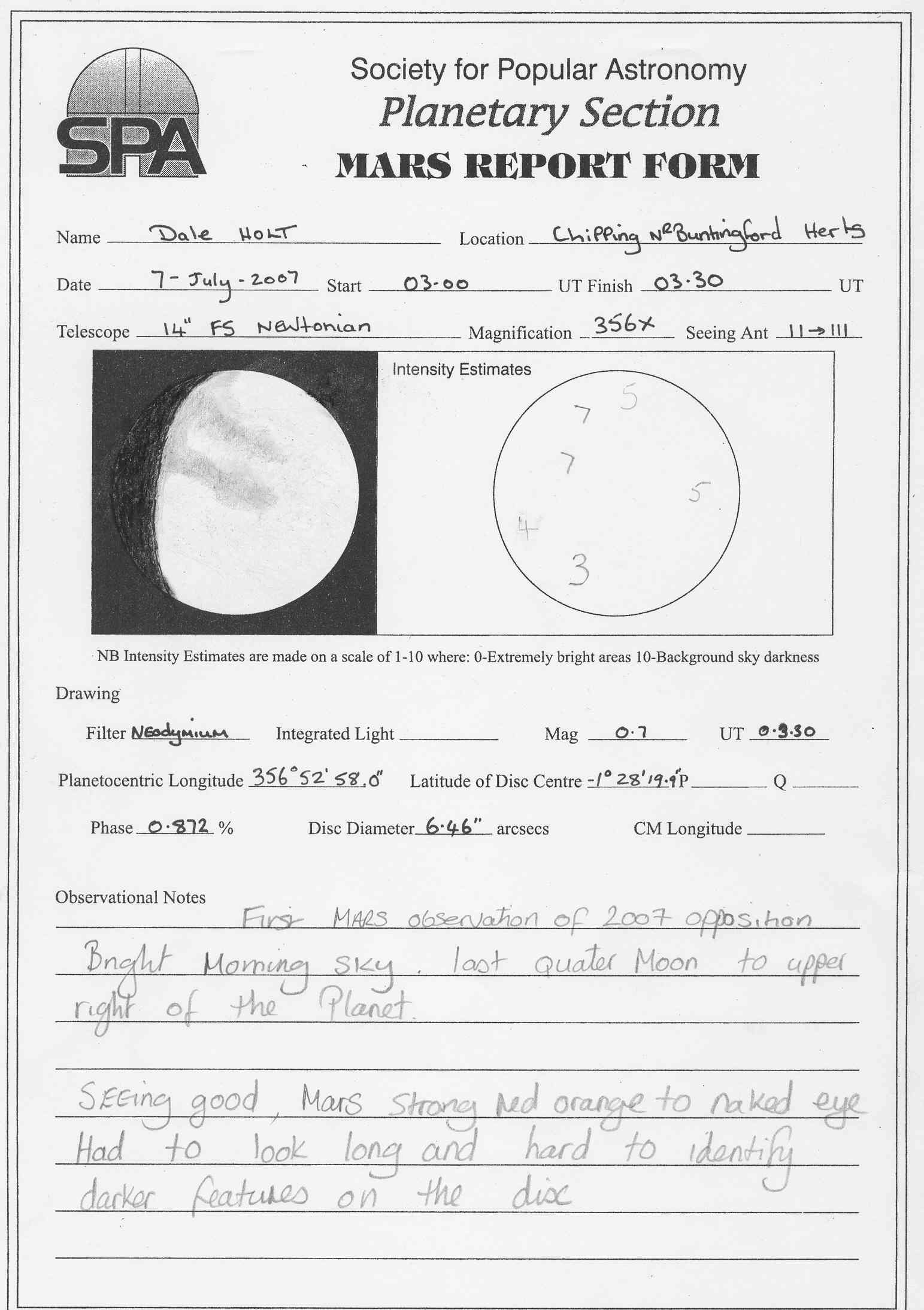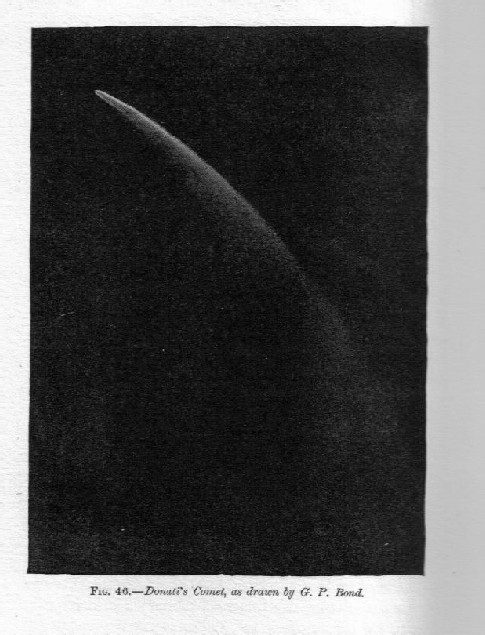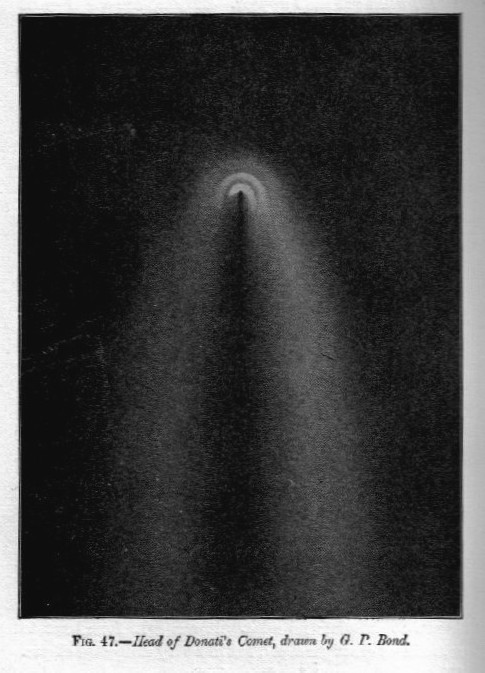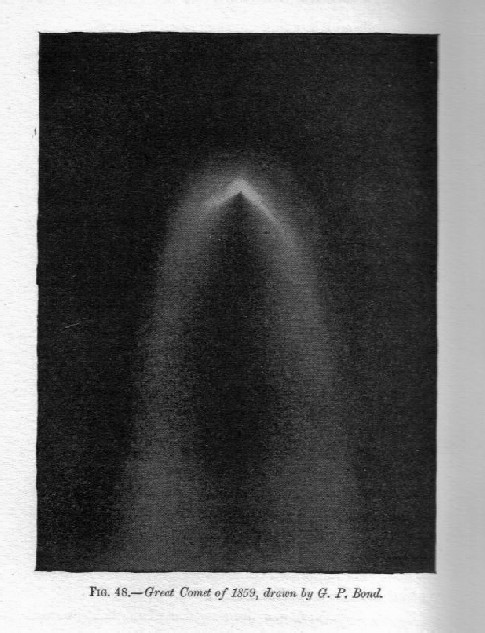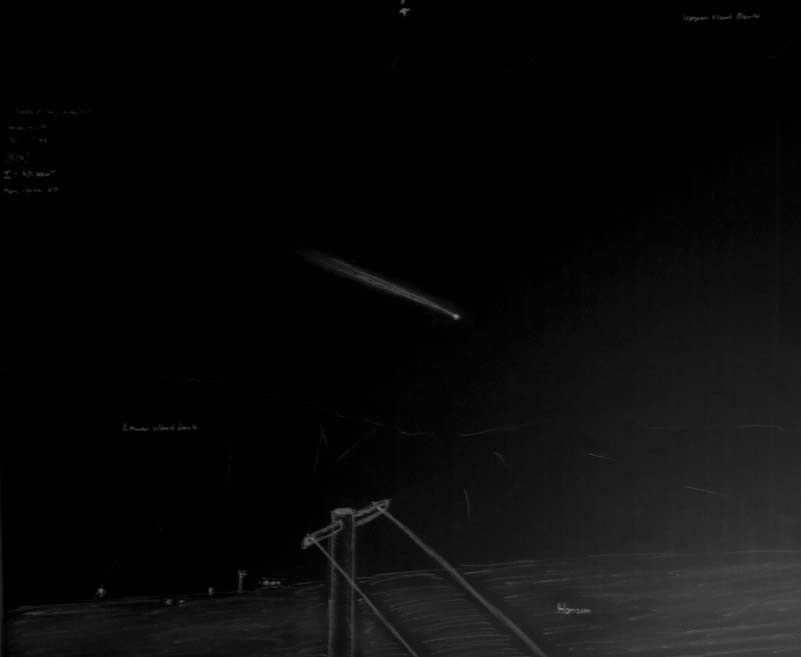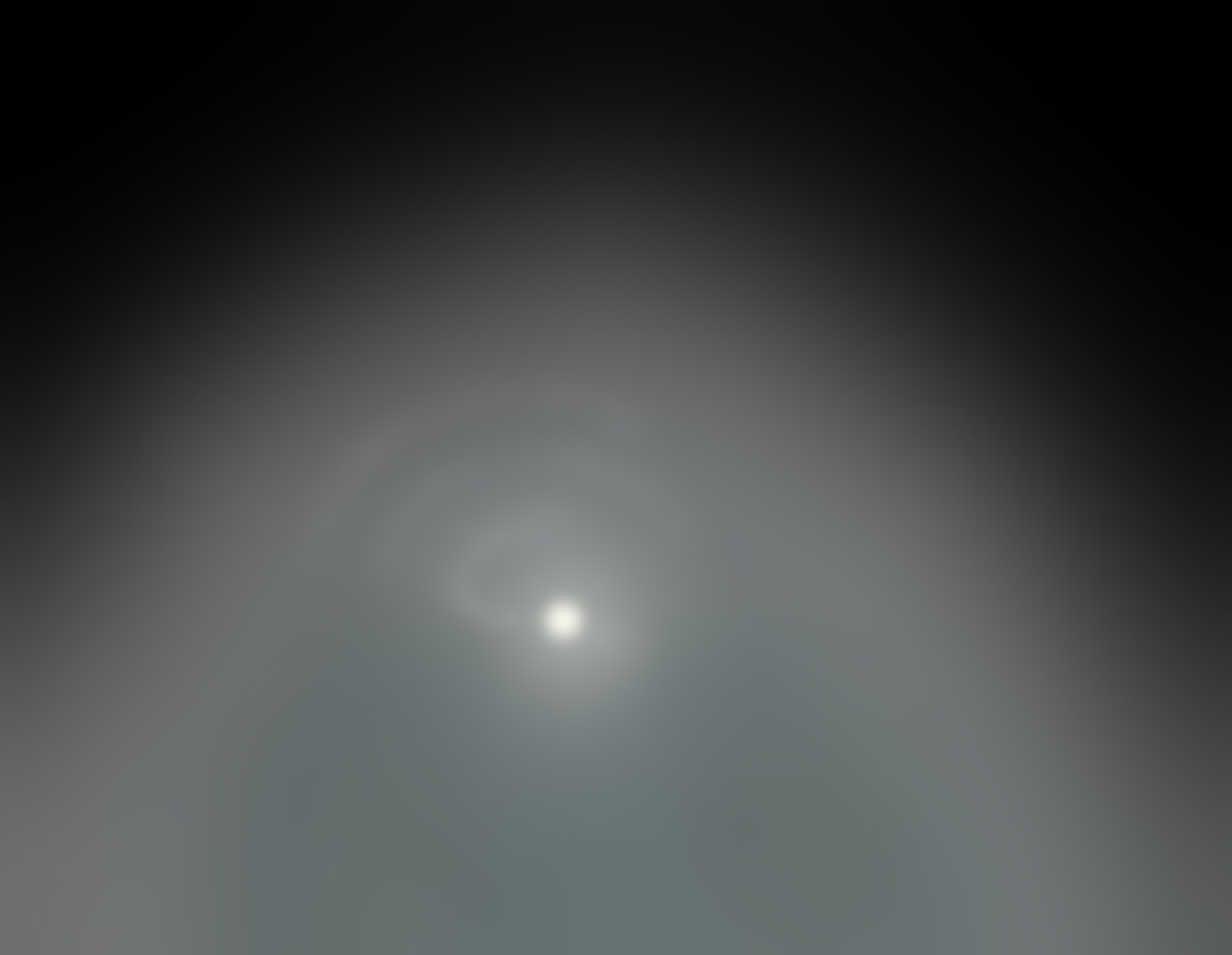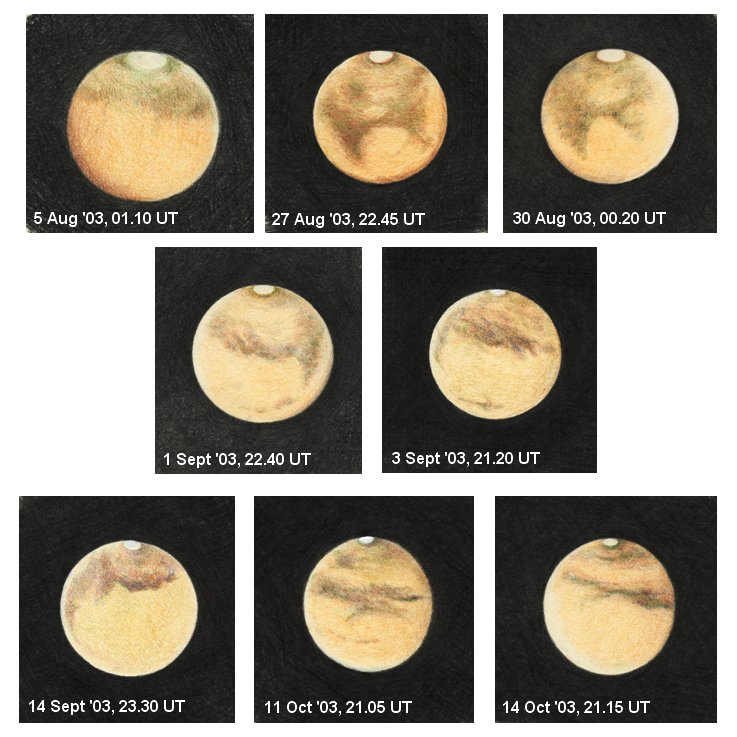In the 1950’s when I was a youngster, Venus was believed to be Earth-like not only
in size but in atmospheric conditions as well. Today it is known that Venus has
the hottest surface temperature of all the planets (457°C on average) and a high
pressure atmosphere of carbon dioxide and sulfuric acid. Venus is always shrouded
in clouds but its phase change and albedo features can be seen with a telescope.
The late spring and summer of 2007 have provided northern observers a great
opportunity to observe Venus in the west just after sunset. Within the week Venus
will reach inferior conjunction and begin to switch over to the morning sky as it
races past earth. Currently Venus is a thin crescent only 44 million km. from
earth and subtending an angular size of nearly 58 seconds of arc. Presently the
planet is too close in alignment with the sun for safe daytime observing but
beginning in September it will rise before the sun in the morning. The 4 drawings
above were made when Venus was between 103 and 51 million km from the Earth.
The first drawing was made with an 18” Newtonian telescope at 381x and the other
three were made with a 10” Newtonian at magnifications between 161x and 241x.
Deep violet, red and polarizing filters were used to bring out the albedo cloud features.
First drawing 7 pm local time June 11, 2007
Second drawing 8 pm local time June 20, 2007
Third drawing 5 pm local time July 1, 2007
Fourth drawing 2 pm local time July 29, 2007
Frank McCabe
Category: Planetary
Early Morning mars
I have attached my latest Mars sketch for your interest. This resulted from my 3rd
observation of Mars during this opposition. Unfortunately seeing was too poor
during the 2nd session to allow me to make a ‘reliable’ sketch.
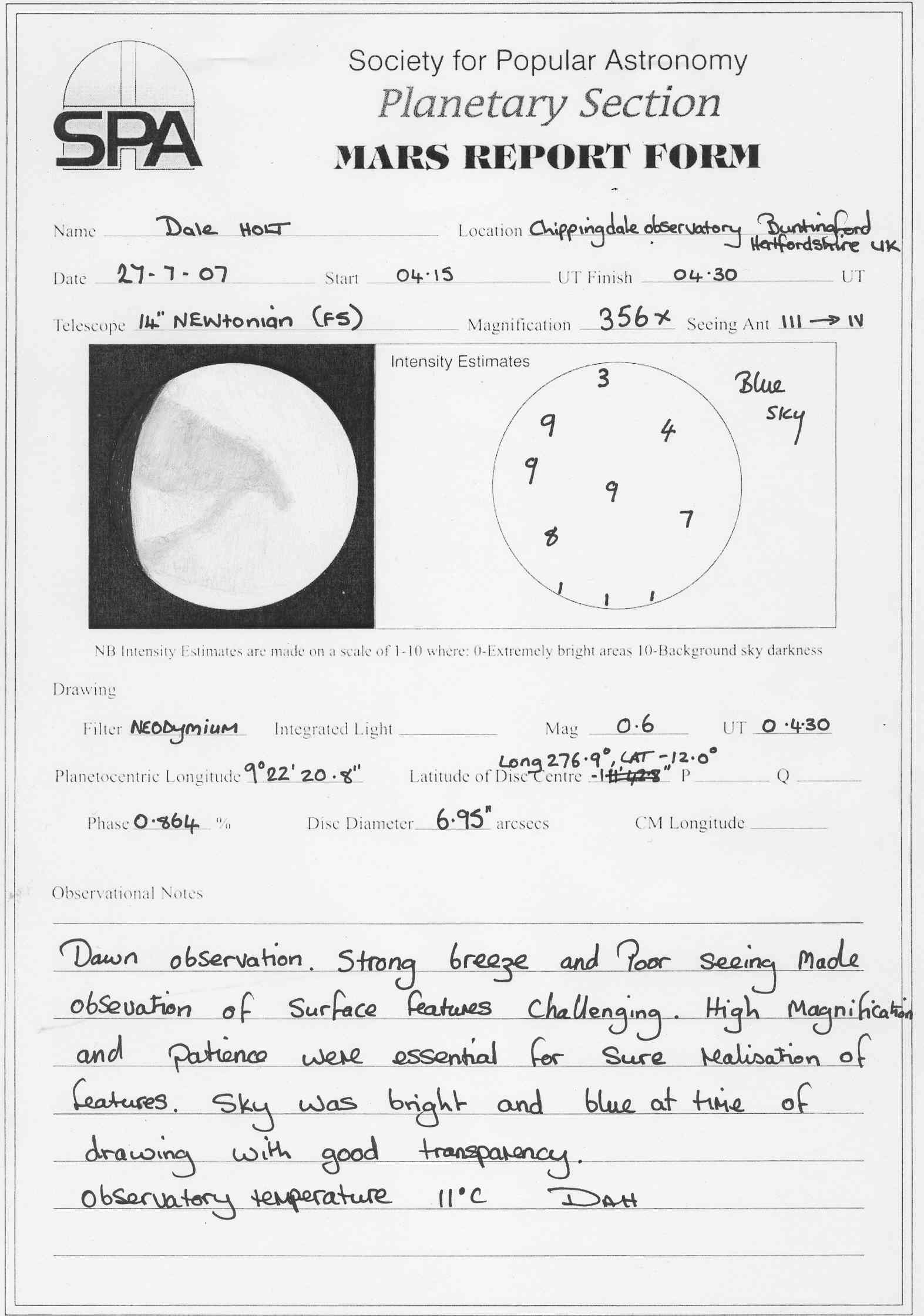
I find observing in the early morning so invigorating and am always on a high
for the rest of the day following such an opportunity. As I have noted so often
before the view gets more detailed and contrasty as the dawn sky brightens. On
this occasion I noted a distinct brightening along the northern polar region
which I hope I have depicted agreeably in my sketch.
When I observe and sketch Mars I never research what I’m likely to see in case
some preconceived image might cloud my vision of reality at the eyepieces.
Dale Holt
Long haired star
I love comets and observe them whenever I can. Most are just faint
celestial smudges but you never know when things can change! When I
observe them I always make a sketch to capture that moment forever, after
all most never return in our life time so it is so nice to look back on your
records. This week I caught up with current Comet Linear C/2006 VZ13 in
Bootes andmade the attached sketch.
Made simply on white cartridge paper with a graphite pencil & blending
stump at the eyepiece. Scanned and turned into a white on black negative.
Warm regards, Dale Holt
Gibbous Ruby World
I had intended to catch up with Mars in June to begin my
observations and sketches of this exciting opposition.
Unfortunately a long run of poor weather in the UK prevented me
from doing this. Finally I caught up with the Red one early on the
morning of Sat 8th July. It was hard work but I sucked out some
detail in the end from the distant ruby planet.
Dale Holt
Here is the original SPA observation form with all the details about Dale’s sketch:
Great Great Grandfathers Comets
The three comet sketches shown here were made by American astronomer and former
director of Harvard College Observatory, George Phillips Bond, son of the first
director William Cranch Bond. George discovered eleven comets and worked closely
with his father at Harvard College Observatory. Together the Bonds are credited
with the discovery of Saturn’s moon Hyperion at the same time famous British
astronomer and co-discoverer, William Lassell, also spotted it in 1848. The Bonds
were also credited with the discovery of the dusty crepe ring as William Lassell
later named it.
Using the new Daguerre’s photographic process, George P. Bond took the first
photograph of a star (Vega) in 1850 and within 7 years he was photographing double
stars like Mizar and attempting to use photography to determine stellar
magnitudes.
One of the most spectacular comets of the 19th century was Donati’s comet named
after its Italian discoverer in Florence. This comet reached a magnitude of -1 in
September of 1858 and had a tail extending 60° across the sky. The first sketch of
Donati’s comet was made without optical aid. The second sketch was made at the
eyepiece of the Harvard College Observatory’s 15 inch refractor. The last sketch
was made at the eyepiece of the same telescope of another comet the following year
called ‘the Great Comet of 1859’. In that same year George took over the
directorship of the observatory from his father. Six years later George P. Bond
died of tuberculosis before reaching his 40th birthday.
Frank McCabe
Sketches are from Astronomy for Everybody by Simon Newcomb© 1902, McClure,
Phillips & Company, pages 268, 270 and 272
The Elusive Great Comet
Great comet C/2006 P1 Mc Naught at 08.00 UT on Jan 19th 2007.
The comet rose above the low eastern horizon along with the rosy glow of the
approaching Sun. It was easily visible to the naked eye complete with tail hanging
above a distant telegraph post. This sketch shows the view in 10X50mm binoculars
with a 1 degree long white dust tail pointing at a shallow angle to the NE with the
‘shadow of the nucleus’ feature splitting the dust tail in two. I only had it in
view for 5 min’s before clouds rolled in but what a view it was!
Mag: -1.7 Dia: 3′ D.C: 9 and only 13 degrees from the sun.
Pencil and paper sketch inverted in photoelements.
Thanks
Martin Mc Kenna
N. Ireland
Joys of Jupiter

This was the first sketch for me in a long while. It is a medium that I had moved
away from as I moved more into astrophotography. This site compeled me to give it
another go. You can see how the Jovian bands have become more mixed in the recent
months. This was also shown on a recent release of photos from Hubble. My sketch was
done with pencil on a sketch pad and reflect what I saw through a 12″ DOB using a
Televue Nagler type 6 7mm ep. It was really fun to experience this medium again. I
will certainly not wait so long for the next sketch. I hope that you enjoy it as
much as I enjoyed doing it.
Hulett Keaton
Eagle Mountain Station
Carpe noctem
Cosmic dust devil
I recently located a pencil drawing of Comet Hale-Bopp in one of old observing
notebooks and decided to reinterpret my hasty sketch using the Photoshop airbrush.
The drawing was made using Tim Puckett’s 24″ reflector with a 55mm Plossl (~90x)
while the comet was drawing close to the horizon. Despite the comet’s low elevation,
I noted a dust tail about five degrees long and a four degree ion tail. The
pseudo-nucleus was almost as bright as Alpha Aurigae (Capella)!
The coma displayed three prominent hoods. The innermost hood appeared to an
astonishing “geyser” jetting from and curving around the nucleus . I can only hope
that the drawing comes close to capturing this amazing feature (I almost named the
sketch “A Bad Drawing of a Great Comet”).
The original drawing was made on the evening of March 29th, 1997.
Dave Riddle
Smyrna, Georgia USA
Eight views of the Great Opposition of 2003
This series of sketches covers my observations of Mars around the opposition
of 2003. Various telescopes were used including a 105mm Astro-Physics apo, a
200mm TEC Fluorite apo, a 13-inch Merz Refractor (circa. 1859, Herstmonceux,
Sussex, England) and a 28-inch Grubb Photo-visual Refractor (circa. 1893,
Royal Observatory, Greenwich, England). Simple graphite sketches with colour
notes were carried out at the eyepiece, generally over a 30 minute to one
hour period, these coloured pencil sketches then being drawn as soon as
possible afterwards. Interestingly the same sort of view is distilled out of
each observation regardless of the aperture being used!
Though the view didn’t appear to change very much from one evening to
another, the shrinking southern polar cap and changing phase of Mars is
distinctly seen over the three month observing period. My personal challenge
for the current Mars apparition is to catch the gibbous phase BEFORE
December 2007 opposition as well as afterwards.
The disc diameter of the sketches (image flipped to the correct orientation)
is approx. 5cm, and south is up.
Sally Russell
With family in tow
Saturn & family
When I pointed my scope at Saturn at the evening of the first May 2007 I was kindly
surprised to see 5 of the Saturnian moons all on one side of the planet!
From left to right and with their magnitude: Titan(M8.4), Iapetus (M10.6), Rhea
(M9.8), Dione (M10.5) & Thetys (M10.3).
For sketches of planets I mostly use Orthoscopic’s, for this one I used the 4mm wich
gave me 250x power.
The sketch was done on standard A4 printerpaper with a template of Saturn printed on
it. I then scanned it and added a grey background and the 5 moons in Microsoft
Paint.
Sketched on the 1st May 2007 from my home in Bornem, Belgium. I used my 8” f/5 dob
at 250x through a 4mm University Optics Ortho eyepiece.
Kris Smet

